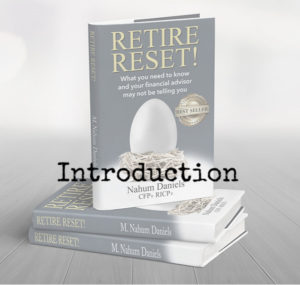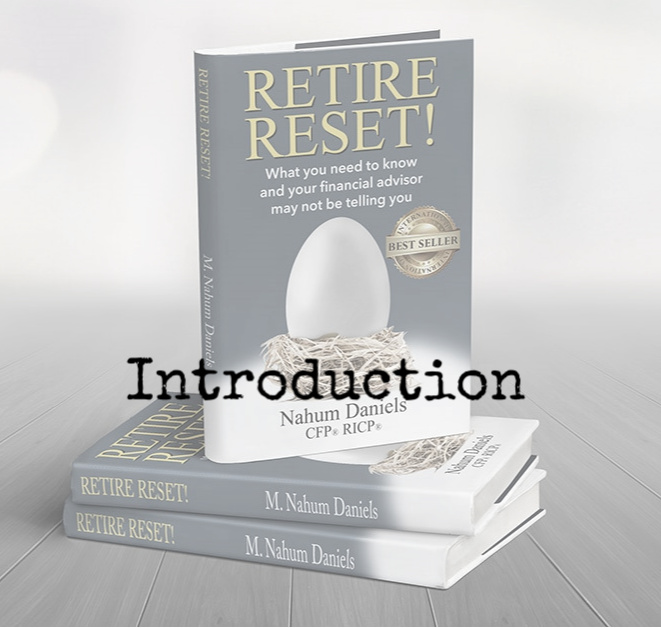
By Nahum Daniels, CFP®, RICP®
If you’ve been wondering about the book I wrote, RETIRE RESET!, we are going to be publishing some excerpts from it every month right here on our blog so that you can learn more. Along the way, you will learn why our firm, Integrated Retirement Advisors, was founded: we’re on a mission to help people with retirement!
To get started, here is part of the book’s introduction:
“Whether you consider it a well-deserved reward for a lifetime of work or a liberating escape from unsatisfying employment, if you’re like most Americans you may be obsessed with the idea of retirement. I know many people who can’t wait to get started.
But the reality is that most members of the older generation today – the 76-million-strong age cohort born between 1946 and 1964 known as “baby boomers” – simply haven’t saved enough. According to a 2016 Price Waterhouse Coopers (PWC) survey, over a third of baby boomers have saved less than $50,000, and of those, most have saved nothing; another 13% have accumulated less than $100,000. Add up the numbers and it becomes clear that half of all baby boomers have less than $100,000 saved for a retirement that could last decades. Only 15% reported nest eggs north of $500,000. We shouldn’t be surprised, therefore, by the Social Security Administration’s 2017 report that 43% of retired singles and 21% of retired couples count on Social Security for 90% or more of their day-to-day living expenses. Clearly that’s a lot of pressure on our social safety net, and that pressure is growing relentlessly as 10,000 boomers enter retirement every day.
By 2030, as many as 76 million members of this one age cohort – almost 20% of our nation’s population – will have reached retirement age, collecting their social security benefits and drawing down their retirement savings in an attempt to maintain the lifestyles (or some semblance of them) to which they’ve grown accustomed. Given dramatic improvements in longevity, modern retirement could extend 30 years or more, which is a very long time to make money last, especially when it may be earning very little. The bottom line? Americans without savings or with very little will not be able to stop working without material compromise pretty much as soon as retirement begins. But even those who may have enough at the outset face the risk of losses that could impose compromises later. And that can be true regardless of how much money you start with if you ignore today’s rules and ratios as applied to retirement income planning, and/or simply run into bad luck.
Which brings us to what this book offers: an investment strategy for individuals with the wherewithal, willingness, and desire to accept personal responsibility for their financial independence in retirement. My approach is intended to help insulate your nest egg from crippling losses while enabling you to grow it and your income in good markets and bad.What I have found over a long career as a financial advisor is that many baby boomers lack the mindset and tactics to optimally leverage their wealth as they transition into and navigate retirement.
This book is intended to address that shortcoming by showing you how to construct what I call the “stable core” retirement portfolio. It’s a portfolio designed to withstand worst-case market scenarios while positioning you to participate in positive market outcomes. It’s income-focused and strives for simplicity as its primary objective. And it aspires to add even more value to your life by protecting you from some of your worst instincts (like buying high and selling low), freeing you from some of your worst fears (like running out of money), and in the end (i.e., during those golden years) enabling you to live generously, unafraid to share your good fortune with the people and causes you care about.
I’ve spent my career as a financial advisor testing this portfolio, observing its behavior under different market conditions, and comparing its performance to the alternatives.During the development process I continuously searched for different ideas and approaches to retirement portfolio construction. Trained in a broad range of investment methodologies and money management styles, I came to the discovery phase with no specific expectations. In fact, I like to think I brought a “Zen mind” to my quest, a non-judgmental beginner’s openness I first learned about as a young man living in Japan in the 1970s. I also brought a desire for simplicity, in the mold of the ancient Taoists who reduced all phenomena to an inter-play of only two antagonistic but complementary energies, the yin and the yang. These two cosmic forces form an integrated whole expressed in the myriad cycles of nature—and they infuse the financial world just as they do all other areas of life.
After decades of professional practice, it has become clear to me that in terms of retirement planning, the conventional mindset falls short. For starters, no matter how well it may have served you in earlier lifecycle phases, the traditional thinking simply doesn’t prepare you for what you’re up against. That’s because the challenges unique to retirement are not encountered in earlier phases of our financial lives; we don’t confront them until we are face-to-face, often with inadequate preparation and sometimes leading to irrecoverable losses. As we will find later on, losses can ruin even the best-laid plan.
In fact, financial success in earlier phases of life often ingrains investment concepts, expectations and biases that are actually contraindicated in retirement. These include some of the most fundamental precepts that underpin investment and retirement practice today, such as the importance of asset selection and portfolio balance, sustainable withdrawal rates and probability analysis. Among these ingrained biases, the most dangerous are complacency and overconfidence. Granted, optimism has its place in healthy human psychology, but it should not be a guiding principle in your retirement planning. Optimism in retirement planning simply isn’t prudent. I recommend that in ideal planning, a healthy wariness of the unknown should be cultivated.
Today, baby boomers are constantly bombarded with pitches emanating from the two poles of the money management industry. In my yin and yang vernacular, I call these poles “banking” and “insurance” and I intend to demonstrate that they are diametric opposites when it comes to retirement strategy and tactics. Put simply, the banking sector originates and transmits risk, and the insurance sector mitigates and absorbs it. I believe that for best results they need to be integrated, weighted properly to serve your specific retirement needs and objectives.”
###
If you would like to discuss your personal retirement situation, please don’t hesitate to call our firm, Integrated Retirement Advisors, at (203) 322-9122.
If you would like to read RETIRE RESET!, it is available on Amazon at this link: https://amzn.to/2FtIxuM

